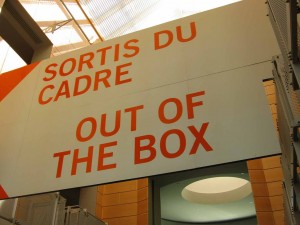Managing information in collaborative tools – 10 tips to consider when implementing SharePoint OOTB June 5, 2014
 The following guest post has been written by Janet Villata from Austrade.
The following guest post has been written by Janet Villata from Austrade.
It summarises the excellent presentation she gave in May at the State Records EDRMS Implementers Group meeting.
Janet’s Information Practice and Governance team at Austrade has recently been involved in assessments of the recordkeeping functionality of SharePoint 2013 out of the box (OOTB).
Austrade has used SharePoint since 2006 and now uses SharePoint 2013 across the organisation.
Ten key tips to consider that came out of the discussion at the EDRMS Implementers Group meeting were as follows:
It needs to be about the business
It is important to understand and support the business benefits that powerful collaborative tools can bring.
For Austrade, although SharePoint does not meet all of their records management needs, it does meet business needs for collaboration.
Its advantage over a shared drive structure is the workflow (deployed in areas where approvals are required), collaboration, version control and multiple access points to content.
SharePoint is a tool that can be designed, configured or customised in many ways. There is not one right way to implement for recordkeeping purposes.
It is important to define the organisation’s particular business and information requirements and to design in a way that these can be met.
Get information managers involved from the start
Ideally, information managers should be involved upfront in SharePoint design to influence the use of content types, metadata schemas etc that can enable the better management of information over time.
It is harder to refit an existing model so proactive engagement can help to achieve a lot.
Be aware of what the information management challenges are
SharePoint is not an EDRMS and lacks some key recordkeeping functionality out of the box.
Janet discussed their key areas of concern which included issues like:
- the inability to retain some key metadata when moving documents to the Records Centre, including some creation and contextual metadata and access controls
- the loss of versions when documents are when moved between sites (including to the Record Centre)
- the common practice of ‘trimming’ or cutting audit trails
- the inability to retain metadata easily when documents are deleted.
Determine what is needed, determine what is possible and make informed decisions
As part of an assessment against your requirements it is important to determine what you cannot achieve by design, and consider what this means for the organisation.
In some cases, risks can be accepted. In others, add-ons or integrations may need to be investigated.
Leverage all existing advice
There is a lot of information available that can help you to assess what SharePoint can and cannot do in relation to recordkeeping.
Janet’s team found Andrew Warland and his blog Records About the World exceptionally useful, and also benefitted from State Records’ advice SharePoint 2010: Recordkeeping considerations.
Austrade also contacted information specialists who had implemented SharePoint and discussed what they had found.
Consider the implications of configuration
In relation to design, it is important to remember that integrations and upgrades can be costly if you customise too much and will require extensive reworking and major change.
Austrade chose to avoid customisation where possible for this reason.
Governance is fundamental
A governance model for information architecture in the system is critical.
It is fundamental to know who is responsible for what and to set out general rules of use, particularly if you have a devolved model where Site Owners have the ability to manage permissions and to make changes.
Part of information governance involves identifying high risk/high value information for specific maintenance and management.
At Austrade, some key records have approval workflows attached so all staff can be confident they are viewing the latest, approved version.
Monitor the system and its use for benchmarking and continuous improvement
It is important to monitor and report on system use and to provide advice and assistance for staff in establishing good information structures.
You need to be connected to the system, understand how it operates, know who is using it and how in order to support key high risk/high value work that is occurring.
Standardised taxonomies and classifications can be powerful tools for system interoperability and information exchange
Controlling the taxonomy and core classification structure in the system will help to establish good and consistent frameworks and interoperability pathways between systems.
Collaborate with colleagues to develop the best solutions for your business environment
Janet’s team at Austrade will continue to work with the business and ICT to define information management solutions that work best with business and technical needs.
Collaboratively they are investigating an effective and long term information governance and management approach.
Thank you!
Thank you Janet, for sharing your fantastic insights and expertise with the EDRMS Implementers Group. It resulted in another great meeting, filled with lots of useful discussion and really valuable information sharing.
The content of this post is for discussion purposes only. It does not represent the official views of Austrade. Any views expressed by Janet in the presentation that this post is based on were hers alone.


Leave a Reply
You must be logged in to post a comment.